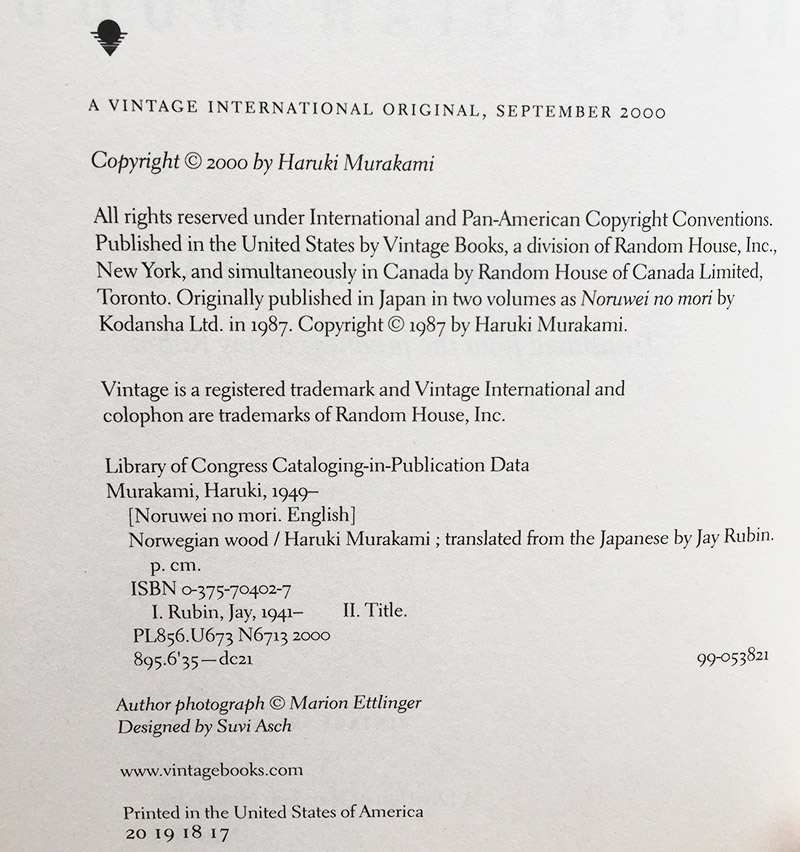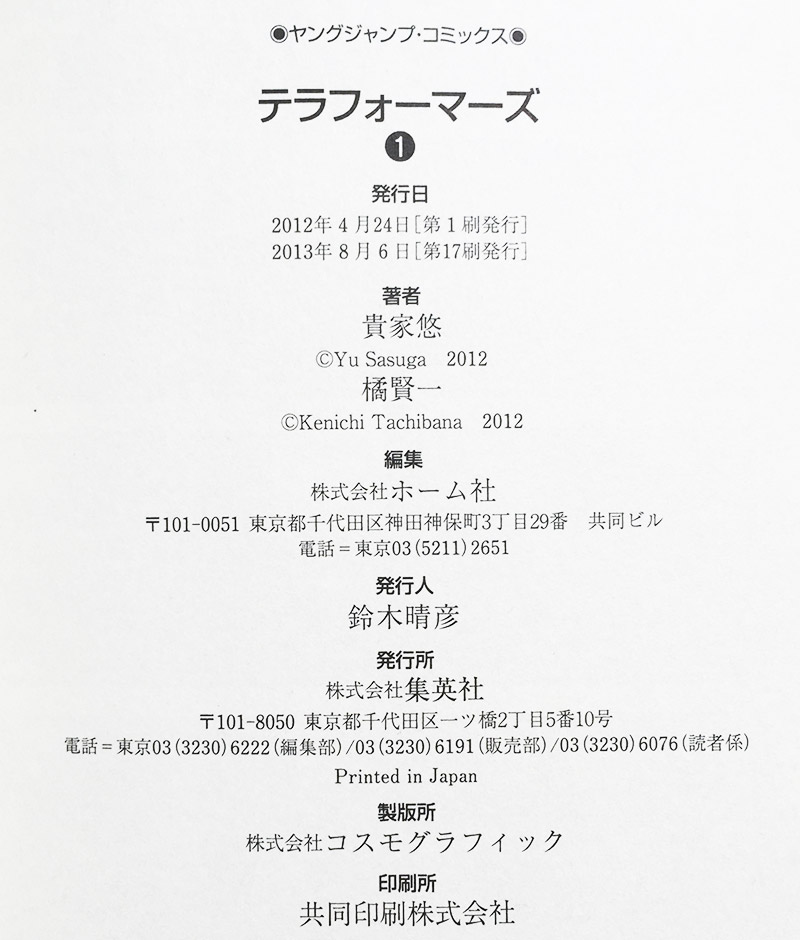Whether you're in high school, college, or grad school, you need to know how to cite your sources. Guides and styles litter the internet but the moment you have to cite something that isn't in English all of those sources of knowledge seem to dry up. That's where we come in! You're about to learn everything there is to know about citing Japanese sources and making your works cited/bibliography page with those sources. Let's get started.
What is a Colophon?
A colophon is something you're probably familiar with but never knew it had a name. It's that page at the beginning of a book that looks a little something like this:

It has all the information you need to write a citation, nicely organized into one easy to access place. Whether you're citing in MLA, Chicago, or APA, everything you need should be here. It has some extra info you don't need, like what font they used, but it's going to be your best friend regardless.
In Japanese this is called okudzuke 奥付. These colophons are a little different from the ones your probably used to. They contain way more information than English language ones usually do. The terms they use can change simply for style purposes, and they are almost always at the back of the book (but sometimes they're at the front like English ones). This may sound daunting at first, but once you know what you're looking for it's actually quite simple!
Important Terms
Knowing what the colophon is will help, but not if you don't know what you're looking for. Here's what you need to have a complete citation:
- Title
- Author
- Publisher
- Place of Publication
- Date of Publication
That's all well and good, but if you don't know those terms in Japanese they aren't very helpful. Learn these words:
- 著 / 著者 – Author
- 発行所 / 出版社 – Publisher
- 出版 / 発行日 / 発行の年月日 – Date of Publication
The title should be pretty obvious, it's going to be on the cover and usually at the top of the colophon. The date is also pretty easy to find since it should be in roman numerals, but if you're using a super old, dusty book it might be written with the Japanese date. If you see something like 昭和64 (Showa 64) that was 1989. But so was Heisei 1. Make sure to brush up on your Japanese calendar skills if you need to. Whenever you encounter these dates, change them over to the western calendar and use roman numerals.
If you'd like to know what the rest of the information you're looking at is, take a look at this vocabulary list:
- 発行者 – Publisher (Person)
- 発行人 – Publisher / Issuer (Person)
- 印刷者 – Printer
- 印刷所 – Printing Office / Press
- 編集 – Editor
- 組版所 – Typesetter
Edition Information:
- 初版 / 初版発行 – First Edition
- 〜版発行 – (number) Edition
- 第〜版発行 – (number) Issue / Edition
- 印行 – Reprinting
Less common nowadays:
- 本文製版 – Text Printing
- 印刷 – Printing
- 製本 /製本所- Book Making / Binding / Book Bindery
- 製版所 – Platemaking shop
Practice Makes Perfect
The best way to learn this kind of thing is with examples and practice. Here are a few colophons. Let's find the information we need to make a citation with some manga!

- Author: 貴家悠
- Title: テラフォーマーズ
- Publisher: 株式会社集英社
- Place of Publication: 東京都
- Date: 2012

- Author: 奥 浩哉
- Title: GANTZ -ガンツ-
- Publisher: 株式会社集英社
- Place of Publication: 東京都
- Date: 2000
That wasn't so bad, right? And they were very similar in style and used all the same terms. That's because, as you now know, they were both published by the same publishing company 株式会社集英社 which translates to Shueisha Publishing Co., Ltd. and is one of the biggest manga publishing companies in Japan.
Style and Consistency
Before we go over what to do with this information, you have to decide what style you're going to use. It doesn't really matter which one you pick, as long as you are consistent throughout your paper and works cited page. Some stylistic choices you get to make are:
- MLA, Chicago, or APA
- Japanese or English
- Italics or No Italics
Your teacher/professor might choose that first one for you. Most of my professors preferred Chicago Style because of it's simple, straightforward citations. But you might have to follow a different one. Make sure you follow whatever those guidelines may be throughout your entire paper! You may never encounter APA (it's mainly used for psychology), so you should probably only focus on MLA and Chicago.
Using Japanese and/or English is the more fun and challenging decision you get to make. But if you provide both Japanese and English for one citation, you have to do it for all of them. That means translating non-translated titles and author names. If your professor doesn't speak Japanese you should probably provide English for their convenience. If your professor is Japanese and you're at a Japanese school you can stick with just Japanese. You can also choose to ditch the Japanese all together and only use English, but I wouldn't recommend it. Especially if you're using a Japanese-only source. Your professors might not like having to work harder to find what you're referencing.
Within your paper you'll need to decide whether you should or should not use italics when using romaji. If you're only using Japanese words in Japanese, you should not italicize them. Ever. Please don't, it's hard to read and looks terrible. But with romaji, it can be helpful for clarification reasons if you at least italicize Japanese words the first time you use them. Then you can leave them as is. Or you can choose to always italicize them. But never ever sometimes do and sometimes don't. If you're going to do one word one way, you need to treat the rest the same.
Works Cited
Your works cited/bibliography is where we put all this new knowledge to work. Once you pick your style, look up the guidelines, and put everything in the right place. This is where you make most of your stylistic choices. Are you using all Japanese, all English, or a mix? Choosing this before you start will make everything go much faster. And if you make your Works Cited before you write your paper, your in text citations will be more organized and easy to do.
After you decide what style you're going to use, you need to know a few important things about citing Japanese sources:
- Last name always comes first in Japanese AND English
- If you include English for one title you must include English for them all
- Use macrons, or do not
When citing using Japanese you should always use Japanese name ordering. That means surname first and given name second. You might be thinking, but isn't that how all citations are done? Kind of. But you do not add a comma after the surname, like you would with an English language citation.
If you decide to provide English for a Japanese title, which can be pretty easy if it's been translated, you need to do it for all of them. This can be a pain if you realize you're using something that has never been translated or talked about in English. This means translating the title yourself. If you aren't comfortable with that, don't use any English at all. If you think that's fun and want some practice (or if your professor requires English and Japanese) give it a try!
Macrons are the long marks, or diacritical marks, you see over vowels to indicate that they are long (also called "heavy"). They let us know that you're saying よう and not よ.
They look like this: ā ī ū ē ō
You'll probably only see ū and ō, because they are the most common, but it is possible to see the others. If you decide to use them, you need to use them the whole time. That means you need to know your romaji well. The only exception for this is when a company or person has a specific stylized preference to their English name. If that's the case, like it is with Shueisha (technically Shuueisha or Shūeisha), then it's common to choose whatever their preference is to avoid misunderstandings.
Once you've figured all that out it's time to get citing! Below are citations in MLA, Chicago, and APA for the Terra Formars manga we cited above.
MLA
貴家悠. テラフォーマーズ. 東京都: 株式会社集英社, 2012. Print.
Sasuga Yuu 貴家悠. Terra Formars テラフォーマーズ. Tokyo 東京都: Shueisha Inc. 株式会社集英社, 2012. Print.
Sasuga Yuu. Terra Formars. Tokyo: Shueisha Inc., 2012. Print.
Chicago
貴家悠. テラフォーマーズ. 東京都: 株式会社集英社, 2012.
Sasuga Yuu 貴家悠. Terra Formars テラフォーマーズ. Tokyo 東京都: Shueisha Inc. 株式会社集英社, 2012.
Sasuga Yuu. Terra Formars. Tokyo: Shueisha Inc., 2012.
APA
貴家悠. (2012). テラフォーマーズ. 東京都: 株式会社集英社.
Sasuga Yuu 貴家悠 (2012). Terra Formars テラフォーマーズ. Tokyo 東京都: Shueisha Inc. 株式会社集英社.
Sasuga Yuu. (2012). Terra Formars. Tokyo: Shueisha Inc.
(If you decided that you wanted to use macrons, Sasuga Yuu's name would look like this: Sasuga Yū.)
In Text Citations
In text citations are formatted the same as your works cited/bibliography page! Sometimes they are very similar, but there are usually small differences.
MLA
MLA loves to be short and sweet. You put the author's last name and the page number(s) you are citing in parenthesis after the quote or piece of information.
The first character to die has her neck snapped by one of the creatures (Sasuga 30).
Sasuga kills the first character within minutes of introducing her (30).
Sasuga's first female character's neck went, "Crack" (30).
Chicago
Chicago uses footnotes and endnotes. They're indicated with numbers either at the end of each page (footnotes) or at the end of the paper (endnotes). Once you've cited something once in text, you get to shorten the rest of the citations that use the same work from then on.
Sasuga Yuu 貴家悠. Terra Formars テラフォーマーズ. (Tokyo 東京都: Shueisha Inc. 株式会社集英社, 2012), 3-40. Sasuga, Terra Formars, 3-40. Make sure you remember to add page numbers when you cite in text.
APA
APA loves footnotes too, but these are more about elaboration than citation of where you got the information from. You should be citing in text with quotations like MLA does. They also really like dates, which makes sense since this is mostly used for psychology.
The main character yelled, "Aki" (Sasuga, 2012, p. 45-46), exactly six times after she died.
Supplemental Practice Citing Japanese Sources
If you'd like to test what you've learned you can! Below are three pdfs that you can use for practice. Use them to make your own works cited page and compare it to the answer sheet!
